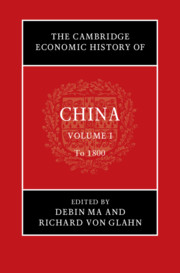Book contents
- The Cambridge Economic History of China
- The Cambridge Economic History of China
- The Cambridge Economic History of China
- Copyright page
- Contents
- Figures
- Maps
- Tables
- Contributors to Volume I
- Acknowledgments
- Note on Citations
- Introduction to Volume I
- Part I Before 1000
- Interlude
- Part II 1000 to 1800
- 7 Ecological Change and Resource Constraints
- 8 Population Change
- 9 Public Finance
- 10 Political Economy
- 11 Law and the Market Economy
- 12 Property Rights and Factor Markets
- 13 The Rural Economy
- 14 Cities and the Urban Economy
- 15 The Monetary System
- 16 Merchants and Commercial Networks
- 17 Foreign Trade
- 18 Production, Consumption, and Living Standards
- Bibliography of Primary Works Cited
- Index
- References
18 - Production, Consumption, and Living Standards
from Part II - 1000 to 1800
Published online by Cambridge University Press: 07 February 2022
- The Cambridge Economic History of China
- The Cambridge Economic History of China
- The Cambridge Economic History of China
- Copyright page
- Contents
- Figures
- Maps
- Tables
- Contributors to Volume I
- Acknowledgments
- Note on Citations
- Introduction to Volume I
- Part I Before 1000
- Interlude
- Part II 1000 to 1800
- 7 Ecological Change and Resource Constraints
- 8 Population Change
- 9 Public Finance
- 10 Political Economy
- 11 Law and the Market Economy
- 12 Property Rights and Factor Markets
- 13 The Rural Economy
- 14 Cities and the Urban Economy
- 15 The Monetary System
- 16 Merchants and Commercial Networks
- 17 Foreign Trade
- 18 Production, Consumption, and Living Standards
- Bibliography of Primary Works Cited
- Index
- References
Summary
The Chinese economy demonstrated significant vigor from the eleventh century to the nineteenth. This period of nine centuries achieved remarkable progress in implementing the imperial examination system, improving literacy, establishing private landownership, developing market institutions, adopting new crops and improved farming technology, strengthening the lineage order, and lifting ordinary people’s capacity to deal with risks. According to the optimistic view, this is also the period during which two economic revolutions, the Tang–Song and Ming–Qing transitions, took place, marked by continuous economic growth and improvement in living standards for the population.1 To other scholars, however, this long period of quantitative growth was largely achieved through population increase, preventing China from escaping the “Malthusian trap.” That is, while the total size of the Chinese economy may have grown due to the rising population, per capita living standards failed to rise above historical norms and might have even declined during the long period. This period’s achievement and impact were nothing comparable to that of the Industrial Revolution which started in eighteenth-century Britain.
- Type
- Chapter
- Information
- The Cambridge Economic History of China , pp. 676 - 709Publisher: Cambridge University PressPrint publication year: 2022



